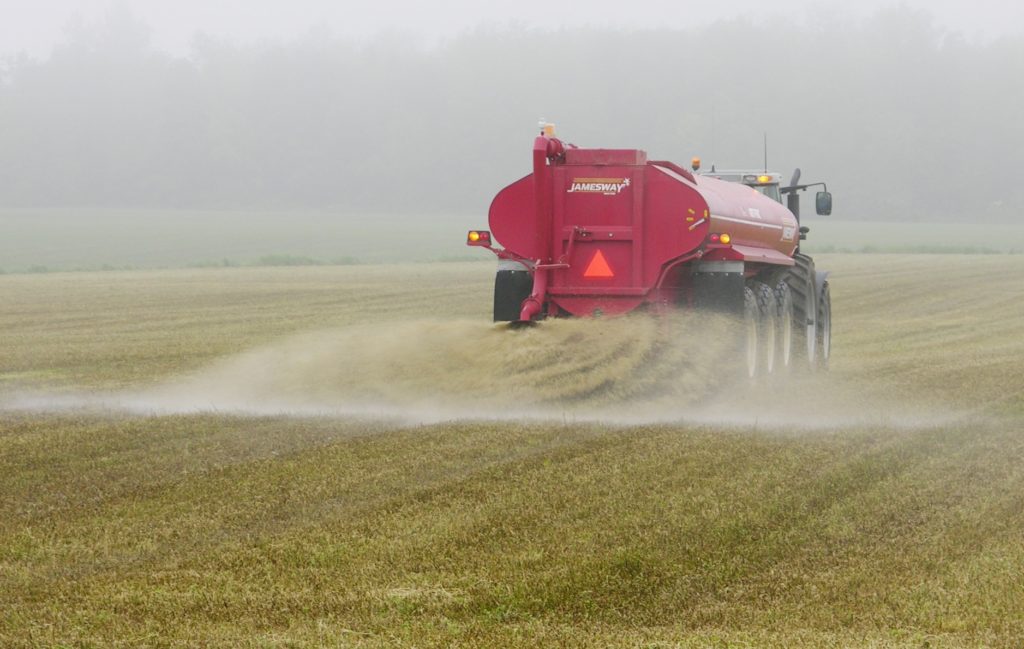Manure should be applied on forages as soon as possible after harvest. Once regrowth starts — typically within 5 days after cutting — equipment traffic can damage active growing points. The trampled crop must start growing all over, which reduces yield and sometimes delays maturity in the tracked areas compared to the rest of the field (see Table 2-2). Applying manure within 5 days of cutting will avoid a yield penalty in trafficked areas on the next cut. This is much easier to achieve in a haylage system than with dry hay.

Injection is the best way to reduce ammonia losses from manure; however, care must be taken in alfalfa stands to minimize crown damage. Research has shown that shallow injection depths of 1.25–2.5 cm (½–1 in.) do not have negative impacts on alfalfa yield. Grass stands are much more tolerant of injection equipment than alfalfa. Injection may not be appropriate on hilly fields, as the manure will run down the trench and pool at the bottom of the slope.
Solid manure can be challenging to spread on a living forage crop. Large chunks of manure can smother the plants. When manure ends up in baleage, bacterial contamination can make livestock sick. For these reasons, solid manure should only be applied to standing forage if it is very fine; solid manure the consistency of corn silage is easy to spread in a thin layer.
Manure Applications and Johnne’s Disease
Application of manure from animals infected with pathogens is a potential method for spreading infection. This becomes a higher risk when the manure is applied to crops used for animal consumption.
Johne’s (yo-nees) disease is a persistent and debilitating bacterial disease that affects the intestines of ruminant animals, including cattle, goats and sheep. The disease is especially problematic in dairy herds, where many cattle can be infected, but only a small percentage of animals (<5%) show the clinical signs of chronic diarrhea and extreme weight loss. These cows also experience decreased milk production. Infected animals, even those not showing sickness, may shed the bacteria in the manure. Johne’s is most often introduced onto farms by the purchase of infected animals.
Johne’s disease is caused by Mycobacterium avium subsp. paratuberculosis (MAP). Calves, especially those under 6 months of age, are most susceptible to infection. Animals under stress are also more susceptible than healthy cattle. The common routes of infection are via ingestion of colostrum or milk contaminated by infected cows. For this reason, Johne’s prevention strategies revolve around calf management and herd testing (refer to Healthy Cows for a Healthy Industry at www.johnes.org). Infection can also occur when feed contaminated with manure containing the MAP pathogen is eaten, particularly by young stock. For this reason, manure application to forages is a potential source of infection.
MAP can survive in manure and water for up to 1 year and on pastures and hay fields for up to 6 months. Exposure to sunlight, drying, high pH, liming and low iron, as well as the processes of fermentation and composting, appear to reduce the survival of MAP. Factors that reduce the survival of the bacteria can also help in better managing manure applied to forages to prevent the spread of MAP.
The following management strategies are suggested for manure management in herds where Johne’s disease has been identified:
- Manure should not be applied to forages in pastures for young stock during the grazing season.
- Top-dress the liquid manure as soon as possible following harvest. This allows the sunlight and desiccation to kill the MAP bacteria.
- Apply manure to fields that will be ensiled or harvested for haylage. Proper fermentation appears to kill the bacteria. Use good ensiling techniques, including proper dry matter content, use of silage inoculant if required, rapid filling, adequate packing and covering as soon as the storage is filled.
- Avoid application of manure to fields that will be harvested for dry hay, especially calf and heifer hay. Where manure is applied, it should be done before any re-growth occurs. A 30-day interval between manure application and harvest should reduce MAP bacteria numbers. However, year-to-year variations in environmental conditions (weather) cannot guarantee complete elimination.
- When choosing a field for manure application, those with a high pH or those that have recently had lime applied are preferred.
- Management strategies that help to control Johne’s Disease will also help to control other common pathogens such as Salmonella, E. coli, Cryptosporidium and several viral diseases that affect young calves and cattle.
